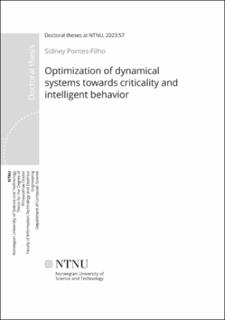| dc.contributor.advisor | Nichele, Stefano | |
| dc.contributor.advisor | Tufte, Gunnar | |
| dc.contributor.advisor | Yazidi, Anis | |
| dc.contributor.advisor | Zhang, Jianhua | |
| dc.contributor.advisor | Hammer, Hugo | |
| dc.contributor.advisor | Sandvig, Ioanna | |
| dc.contributor.author | Pontes-Filho, Sidney | |
| dc.date.accessioned | 2023-02-28T13:51:10Z | |
| dc.date.available | 2023-02-28T13:51:10Z | |
| dc.date.issued | 2023 | |
| dc.identifier.isbn | 978-82-326-6953-0 | |
| dc.identifier.issn | 2703-8084 | |
| dc.identifier.uri | https://hdl.handle.net/11250/3054723 | |
| dc.description.abstract | With the progress of computing power, artificial intelligence (AI) systems are able to achieve outstanding results that surpass human-level performance on some tasks, such as image recognition. Mainstream AI systems are only able to learn one or more specific tasks, and they commonly fail to go beyond what they were trained for. To have a real breakthrough in the field of AI, those systems require adaptability and the capacity to learn general tasks and data distributions. Such characteristics are among the objectives of artificial general intelligence (AGI) research. The inspiration from biology, neuroscience, and complex systems may guide the development of AGI because AI systems are still rigid instead of self-organizing. Therefore, the research reported in this thesis aims at intelligent dynamical systems that resemble the brain, such as the brain’s critical behavior that may allow the cortex to self-organize to criticality in order to increase computational capacity. The plan to accomplishsuch systems encompasses the usage of optimization methods to find adequate interactions of the components in a complex system, how they are connected with each other, and how they adapt those interactions and connections overtime. The dynamical systems investigated in this research are cellular automata, Boolean networks, and recurrent neural networks with abstract neuron models or with more biologically plausible ones (spiking neurons). Themain optimization method applied in these systems is evolutionary computa-tion or artificial evolution. There are three parts in the presented research. Thefirst uses a deep neural network library to evolve dynamical systems towardscriticality. The second part works on the complexification of spiking neuralnetworks with adaptive synapses for solving tasks in mutable environments.The last one involves the application of neural cellular automata for control-ling robots and even developing their morphology with artificial embryogeny.The results of this research attempt to address some unanswered questionsrelated to the practicality, methodology, and benefits of applying dynamicalsystems in AI. | en_US |
| dc.language.iso | eng | en_US |
| dc.publisher | NTNU | en_US |
| dc.relation.ispartofseries | Doctoral theses at NTNU;2023:57 | |
| dc.relation.haspart | Paper A1: Pontes-Filho, Sidney; Lind, Pedro; Yazidi, Anis; Zhang, Jianhua; Hammer, Hugo Lewi; Mello, Gustavo; Sandvig, Ioanna; Tufte, Gunnar; Nichele, Stefano. EvoDynamic: A Framework for the Evolution of Generally Represented Dynamical Systems and Its Application to Criticality. I: Applications of Evolutionary Computation. Springer 2020 ISBN 978-3-030-43722-0. s. 133-148. © 2020 Springer | en_US |
| dc.relation.haspart | Paper A2: Pontes-Filho, Sidney; Lind, Pedro; Yazidi, Anis; Zhang, Jianhua; Hammer, Hugo Lewi; Mello, Gustavo; Sandvig, Ioanna; Tufte, Gunnar; Nichele, Stefano. A neuro-inspired general framework for the evolution of stochastic dynamical systems: Cellular automata, random Boolean networks and echo state networks towards criticality. Cognitive Neurodynamics 2020 This is an open access article under the CC BY license | en_US |
| dc.relation.haspart | Paper A3: Pontes-Filho, Sidney; Lind, Pedro; Nichele, Stefano. Assessing the robustness of critical behavior in stochastic cellular automata. Physica D : Non-linear phenomena 2022 ;Volum 441. s. -This is an open access article under the CC BY license | en_US |
| dc.relation.haspart | Paper B1: Pontes-Filho, Sidney; Nichele, Stefano. A Conceptual Bio-Inspired Framework for the Evolution of Artificial General Intelligence. International Conference on High Performance Computing & Simulation; 2021-03-22 - 2021-03-26 | en_US |
| dc.relation.haspart | Paper B2: Pontes-Filho, Sidney; Olsen, Kristoffer; Yazidi, Anis; Riegler, Michael; Halvorsen, Pål; Nichele, Stefano. Towards the Neuroevolution of Low-level artificial general intelligence. Frontiers in Robotics and AI 2022 ;Volum 9. s. - This is an open access article under the CC BY license | en_US |
| dc.relation.haspart | Paper C1: Variengien, Alexandre; Pontes Filho, Sidney; Glover, Tom Eivind; Nichele, Stefano. Towards Self-organized Control: Using Neural Cellular Automata to Robustly Control a Cart-pole Agent. : Innovations in Machine Intelligence, Crosslabs, Vol. 1/2021 2021 ;Volum 1.14 s. | en_US |
| dc.relation.haspart | Paper C2: Pontes Filho, Sidney; Walker, Kathryn; Najarro, Elias; Nichele, Stefano; Risi, Sebastian. A Unified Substrate for Body-Brain Co-evolution. 2nd International Conference on Embodied Intelligence; 2022-03-23 - 2022-03-25. This is an open access article under the CC BY license | en_US |
| dc.relation.haspart | Paper C3: Nadizar, Giorgia; Medvet, Eric; Nichele, Stefano; Pontes-Filho, Sidney. Collective control of modular soft robots via embodied spiking neural cellular automata. From Cells to Societies: Collective Learning Across Scales at Tenth International Conference on Learning Representations (ICLR 2022). This is an open access article under the CC BY-NC-SA license | en_US |
| dc.title | Optimization of dynamical systems towards criticality and intelligent behavior | en_US |
| dc.type | Doctoral thesis | en_US |
| dc.subject.nsi | VDP::Teknologi: 500 | en_US |
